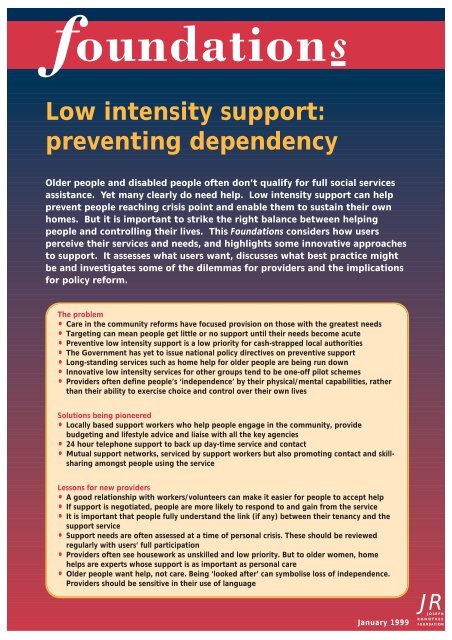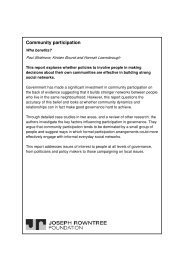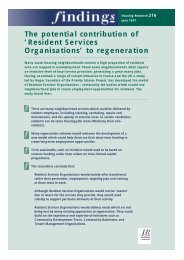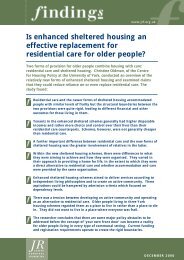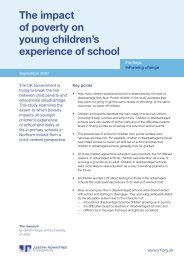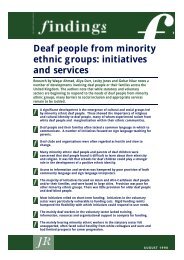Low intensity support - Joseph Rowntree Foundation
Low intensity support - Joseph Rowntree Foundation
Low intensity support - Joseph Rowntree Foundation
You also want an ePaper? Increase the reach of your titles
YUMPU automatically turns print PDFs into web optimized ePapers that Google loves.
<strong>Low</strong> <strong>intensity</strong> <strong>support</strong>:<br />
preventing dependency<br />
Older people and disabled people often don’t qualify for full social services<br />
assistance. Yet many clearly do need help. <strong>Low</strong> <strong>intensity</strong> <strong>support</strong> can help<br />
prevent people reaching crisis point and enable them to sustain their own<br />
homes. But it is important to strike the right balance between helping<br />
people and controlling their lives. This <strong>Foundation</strong>s considers how users<br />
perceive their services and needs, and highlights some innovative approaches<br />
to <strong>support</strong>. It assesses what users want, discusses what best practice might<br />
be and investigates some of the dilemmas for providers and the implications<br />
for policy reform.<br />
The problem<br />
• Care in the community reforms have focused provision on those with the greatest needs<br />
• Targeting can mean people get little or no <strong>support</strong> until their needs become acute<br />
• Preventive low <strong>intensity</strong> <strong>support</strong> is a low priority for cash-strapped local authorities<br />
• The Government has yet to issue national policy directives on preventive <strong>support</strong><br />
• Long-standing services such as home help for older people are being run down<br />
• Innovative low <strong>intensity</strong> services for other groups tend to be one-off pilot schemes<br />
• Providers often define people’s ‘independence’ by their physical/mental capabilities, rather<br />
than their ability to exercise choice and control over their own lives<br />
Solutions being pioneered<br />
• Locally based <strong>support</strong> workers who help people engage in the community, provide<br />
budgeting and lifestyle advice and liaise with all the key agencies<br />
• 24 hour telephone <strong>support</strong> to back up day-time service and contact<br />
• Mutual <strong>support</strong> networks, serviced by <strong>support</strong> workers but also promoting contact and skillsharing<br />
amongst people using the service<br />
Lessons for new providers<br />
• A good relationship with workers/volunteers can make it easier for people to accept help<br />
• If <strong>support</strong> is negotiated, people are more likely to respond to and gain from the service<br />
• It is important that people fully understand the link (if any) between their tenancy and the<br />
<strong>support</strong> service<br />
• Support needs are often assessed at a time of personal crisis. These should be reviewed<br />
regularly with users’ full participation<br />
• Providers often see housework as unskilled and low priority. But to older women, home<br />
helps are experts whose <strong>support</strong> is as important as personal care<br />
• Older people want help, not care. Being ‘looked after’ can symbolise loss of independence.<br />
Providers should be sensitive in their use of language<br />
January 1999<br />
JR<br />
JOSEPH<br />
ROWNTREE<br />
FOUNDATION
<strong>Low</strong> <strong>intensity</strong> <strong>support</strong>: preventing dependency<br />
Reforms to community care have emphasised<br />
independence, choice and dignity. But the focus has<br />
been on those with the greatest needs. There has so far<br />
been no attempt to issue national strategic directives<br />
on preventive services.<br />
Residential care continues to dominate for many<br />
people with learning difficulties and low <strong>intensity</strong><br />
<strong>support</strong> services - such as help with housework for<br />
older people - continue to be downgraded as a<br />
priority. Resources remain scarce for investment in pilot<br />
projects which could test the cost-effectiveness and<br />
viability of low <strong>intensity</strong> <strong>support</strong> services.<br />
Research for the <strong>Joseph</strong> <strong>Rowntree</strong> <strong>Foundation</strong> has<br />
tracked a number of low <strong>intensity</strong> <strong>support</strong> schemes<br />
that prevent older or disabled people (including those<br />
with mental health problems and learning difficulties)<br />
losing control over their lives. Other groups may also<br />
benefit from this kind of <strong>support</strong>, for example, people<br />
recovering from drug and alcohol dependency and<br />
young people leaving care.<br />
Typically involving occasional but regular contact with<br />
staff or volunteers, these services enable people to care<br />
for themselves and maintain their homes, reducing the<br />
need for costly residential care. Yet social services<br />
departments are often reluctant to divert resources to<br />
promote quality of life and community integration as<br />
an end in itself, without clear evidence of costeffectiveness.<br />
But those involved in schemes that are up and running<br />
- new pilots and existing (sometimes threatened)<br />
services alike - are convinced they work. This is the<br />
view not just of providers, but of users too.<br />
Support on whose terms?<br />
The users’ perspective<br />
It is critical that providers assess low <strong>intensity</strong> services<br />
from the recipients’ point of view. Those who benefit<br />
most usually cite a good relationship with their <strong>support</strong><br />
workers. This will often be based on a sympathetic<br />
approach to users’ own priorities. For example, older<br />
people may particularly value help with cleaning their<br />
homes, disabled people may want a regular visit to the<br />
pub and so on. Social activities are particularly valued.<br />
A successful scheme will promote social inclusion by<br />
helping people integrate with the wider community.<br />
In-depth research into users’ views also often identifies<br />
shortcomings in how people are <strong>support</strong>ed within<br />
mainstream housing. A recent study of ‘floating<br />
<strong>support</strong>’ services in Scotland found widespread<br />
satisfaction, but a lack of clarity about funding and<br />
entitlements. For example, many tenants were unaware<br />
that they were paying for <strong>support</strong> through rent or<br />
service charges.<br />
Helpers or friends? Befriending schemes<br />
There is a continuing debate amongst providers of<br />
<strong>support</strong> services over how appropriate it is for the<br />
professionals involved to form friendships with their<br />
clients. Yet people almost always prefer this.<br />
Befriending recognises this. It is one of the lowest<br />
<strong>intensity</strong> <strong>support</strong> services available, a low-cost<br />
complementary service rather than a substitute for<br />
home care or other <strong>support</strong>.<br />
Befrienders are volunteers. Recent research suggests<br />
that people value the fact that others choose to<br />
spend time with them, rather than being under<br />
professional or family obligation to do so. Matching<br />
is the key to success. It is ideally based on shared<br />
interests, living near one another and similar<br />
personalities and age. But selecting users can<br />
compound social exclusion if those thought<br />
‘difficult’ are rejected. Once matched with a user,<br />
the befriender typically meets them once a week,<br />
although the nature and frequency of contact will<br />
vary according to the scheme and the priorities of<br />
those involved: “I really enjoy having somebody who<br />
will take me out to the pub for a pint, especially on<br />
Sundays.”<br />
Befriending relationships typically last over a year,<br />
which implies some success, and they are valued by<br />
those receiving the service. Volunteers also report<br />
benefits: improved job prospects, new leisure<br />
opportunities and wider social networks. A number<br />
of users would like to become volunteers in the<br />
future. Befriending organisations encourage this to<br />
promote their inclusion in community life.<br />
The study found that those voluntary organisations<br />
that offer befriending usually provide other services<br />
too (for example, advice and advocacy, personal<br />
care, campaigning and ‘good neighbour’ services).<br />
Over 60 per cent of schemes receive some local<br />
authority funding, with 30 per cent of schemes<br />
provided on a borough-wide basis. However, 60 per<br />
cent of schemes report problems recruiting<br />
volunteers, 20 per cent problems attracting users.<br />
2
There was also a perceived link between the tenancy<br />
and ongoing <strong>support</strong>, especially among younger<br />
people: “I had to agree to get help so I could get my<br />
house and I did want help but I’m not sure what would<br />
happen if I didn’t need help any more.”<br />
Many of the participants in the Scottish study had had<br />
their <strong>support</strong> needs assessed at a time of personal crisis.<br />
In retrospect, they felt they had not been able to<br />
participate fully in planning their future <strong>support</strong> needs.<br />
Most were not aware of their formal care plans. This<br />
illustrates the importance of regularly involving people<br />
in their own <strong>support</strong> and checking their knowledge of<br />
what has been agreed.<br />
if the service does not try to carry out tasks they can<br />
still do for themselves. People set their own<br />
parameters: for some it is doing their own shopping,<br />
for others cooking or housework.<br />
“I think the time to go into a home is when you can’t<br />
cook for yourself.”<br />
They are also sensitive to being ‘taken advantage of’.<br />
Having unknown men doing maintenance and repair<br />
work can lead to fears for safety. The services provided<br />
by Care and Repair organisations are highly valued<br />
because people feel they can trust the workers<br />
involved.<br />
The way the wider community is introduced to<br />
people’s needs is also crucial to users. At its worst,<br />
neighbours have been ‘warned’ when users move in.<br />
This is considered a harmful breach of confidentiality.<br />
Other key findings included:<br />
Key lessons<br />
• Professionals often see housework as unskilled and<br />
low priority. But older women feel home helps are<br />
highly skilled. To them, housework is as important<br />
as personal care<br />
• Although information may be available to users, it<br />
is not always understood<br />
• An out-of-hours service is needed, even if just<br />
telephone-based<br />
• People may know how to make a complaint, but<br />
not all have the confidence to do so<br />
• Some <strong>support</strong> workers may not have sufficient<br />
awareness of mental illness to <strong>support</strong> people<br />
newly discharged from psychiatric hospital<br />
• Users want the service to help the wider<br />
community understand their needs<br />
• There is little evidence that people have a choice<br />
over the <strong>support</strong> they receive<br />
Housework is real work<br />
Research shows that the home’s appearance is<br />
particularly important to older women. Keeping the<br />
house up is akin to keeping themselves up. Help<br />
with housework can sustain this self-respect as well<br />
as practically preventing/delaying the need for<br />
residential care. So older people see the withdrawal<br />
of this help as social services failing to understand<br />
what is important to them:<br />
“There’s lots of things they [social services] don’t<br />
understand. They don’t think housework is necessary.<br />
You’re just supposed to sit here and look at it.”<br />
Older people’s priorities<br />
Some people using low <strong>intensity</strong> <strong>support</strong> services will<br />
have come from institutional care into the community,<br />
others will have moved from parental homes to other<br />
protective environments. Many older people though,<br />
will already be established within mainstream housing.<br />
Everyday help - with housework, gardening, laundry,<br />
home maintenance and repairs - can help them stay<br />
there.<br />
Older people do not equate their needs for help with<br />
loss of independence. Tasks which they can no longer<br />
manage alone are usually willingly given up - but only<br />
Undone housework can be a constant reminder of<br />
what older people can no longer do. This can have a<br />
negative impact on their mental health and<br />
motivation to manage:<br />
“You go down if you let the house go down, don’t<br />
you?”<br />
Although older men may be less concerned than<br />
women about the appearance of their homes, some<br />
will take on more housework tasks to help their<br />
wives maintain the home’s appearance as the<br />
couple get older. When widowed, the grief<br />
experienced by women can be exacerbated by the<br />
loss of this help.<br />
3
<strong>Low</strong> <strong>intensity</strong> <strong>support</strong>: preventing dependency<br />
• Having to rely on their family can undermine older<br />
people’s sense of independence. Asking for help<br />
can feel like an admission they can’t cope. Access<br />
to alternative forms of assistance overcomes this<br />
• Those with higher levels of need who meet<br />
eligibility criteria often only get minimal help with<br />
housework. This is because the ‘personal care’<br />
element of their care package uses up the<br />
resources allocated to them<br />
the official world. But they also ensure that the<br />
members of the network meet each other regularly.<br />
This is not meant to be a substitute for professional<br />
assistance, but to increase the resilience of the<br />
networks and ensure they are as cohesive as possible.<br />
Success, however, requires a balance between tenants<br />
willing to take a lead and those who may be more<br />
passive. Although generally not a problem, too many<br />
of the latter can undermine a network’s effectiveness.<br />
Group <strong>support</strong> networks<br />
For many people, independence can in practice also<br />
mean isolation. One way to tackle this is to offer<br />
<strong>support</strong> services to groups rather than just to<br />
individuals. Mutual <strong>support</strong> networks have been<br />
pioneered in a number of low <strong>intensity</strong> <strong>support</strong><br />
services, with some success, notably KeyRing and<br />
Home-Link (see boxes).<br />
Networks of tenants in general needs housing are<br />
<strong>support</strong>ed by a community worker and also by the<br />
mutual <strong>support</strong> of the group members. Access is<br />
typically agreed three ways by social services, housing<br />
and the agency itself. Staff are appointed to help<br />
people settle into the network, and to provide<br />
continuing <strong>support</strong>. They provide one-to-one <strong>support</strong><br />
to their clients, helping tenants budget and deal with<br />
Tenants in mutual <strong>support</strong> networks are often anxious<br />
that professionals should not interfere too much.<br />
Support can be offered and negotiated, but not<br />
imposed. As a result, the service is more likely to be<br />
approved of by those who use it.<br />
Key lessons<br />
• The sort of <strong>support</strong> provided by KeyRing costs<br />
around £50 a week per user. A network is selffinancing<br />
if only three out of nine tenants in each<br />
network would be in residential care if the service<br />
were unavailable<br />
• Purchasers need to think carefully about the kinds<br />
of neighbourhoods in which schemes are located,<br />
and how people are <strong>support</strong>ed to manage their<br />
relationships with members of the local<br />
community<br />
The KeyRing approach<br />
The KeyRing agency is one of the pioneers of mutual <strong>support</strong>. It currently has 15 ‘living <strong>support</strong>’ networks, most<br />
in Greater London. Services are primarily targeted at people with learning difficulties who have basic self-care<br />
skills, but still need continuing or intermittent <strong>support</strong>. Everyone in the network (usually nine people) knows<br />
where everyone else lives and has their phone number.<br />
Networks are co-ordinated by community living workers, who spend 10 to 12 hours a week with members and<br />
live in the same area. In return, they get free accommodation and help with some household bills. Although most<br />
work part-time in other jobs, they are far more accessible than in many equivalent services. Telephone <strong>support</strong> is<br />
available during the evenings and at weekends.<br />
KeyRing also helps tenants manage their relationship with a much bigger network - the local community. For the<br />
model to work, KeyRing needs to find neighbourhoods where there is sufficient turnover of social housing for a<br />
network to become established within a reasonable timescale. This sometimes means <strong>support</strong>ing people in<br />
environments that are not always ideal. KeyRing carefully audits communities where a new network is being<br />
considered, helps tenants to develop defensive strategies, and <strong>support</strong>s those who wish to take action if they have<br />
experienced any harassment.<br />
4
<strong>Low</strong> <strong>intensity</strong> <strong>support</strong>: preventing dependency<br />
The Home-Link model<br />
Help for people with mental health problems in general<br />
needs housing<br />
communication and understanding has also been<br />
improved. These benefits have led to the service being<br />
expanded throughout the East Riding of Yorkshire.<br />
Home-Link is an inter-agency service based in the East<br />
Riding. It provides permanent housing and low-level,<br />
practical <strong>support</strong> to people with enduring mental<br />
health problems - including mutual <strong>support</strong> networks.<br />
The housing department allocates secure tenancies to<br />
people, usually near each other. Many properties are<br />
connected to a highly valued, 24-hour ‘lifeline’ service.<br />
People contact their workers freely between visits for<br />
advice or reassurance.<br />
Home-Link workers spend around 5 or 6 hours with<br />
each user a month, providing help with budgeting,<br />
bills and other household matters. They are<br />
deliberately not qualified as mental health<br />
professionals, to avoid a medical emphasis. Home-Link<br />
has also learnt from KeyRing and introduced mutual<br />
<strong>support</strong> networks.<br />
Clear aims and objectives are seen to have contributed<br />
to the success of the scheme:<br />
Aims<br />
Home-Link aims to provide people with enduring<br />
mental health problems with the opportunity to live in<br />
permanent, good quality housing with <strong>support</strong>. Home-<br />
Link aims to provide a service which will:<br />
• Integrate people into the community<br />
• Promote independent living and reduce isolation<br />
• Increase options in the range of <strong>support</strong>ed<br />
accommodation<br />
• Prevent a deterioration of people’s mental health<br />
condition, thereby hopefully reducing the need for<br />
admission to hospital<br />
• Deliver flexible <strong>support</strong> to people in permanent,<br />
good quality accommodation<br />
Benefits to users<br />
Over half of those interviewed had felt an<br />
improvement in their mental health since joining the<br />
scheme. Many thought the <strong>support</strong> had helped reduce<br />
their anxiety and strengthened their ability to be<br />
independent.<br />
“If I’d have had to set up on my own, I might not have<br />
managed it. I might not have made the move.”<br />
Benefits to agencies<br />
Health and social services staff feel that Home-Link helps<br />
free up professional time to concentrate on people with<br />
more severe needs. Housing staff feel there have been<br />
management benefits: no complaints have been received<br />
about any of the Home-Link users or their neighbours,<br />
and no rent arrears have built up. Inter-departmental<br />
Objectives<br />
• To develop good working partnerships between<br />
health, housing, social services and voluntary<br />
agencies, using existing organisational networks,<br />
in order to deliver integrated housing and <strong>support</strong><br />
services<br />
• To allocate or help secure good quality ordinary<br />
housing for people with mental health problems<br />
which offers security of tenure<br />
• To provide continuous <strong>support</strong> to Home-Link<br />
members, as appropriate<br />
• To provide advice and assistance to facilitate<br />
access to and take up of other resources and<br />
services<br />
• To foster the development of social links and<br />
contact with outside organisations via a Home-<br />
Link network<br />
What works best<br />
Providers seeking to learn from pilot schemes’ best<br />
practice should consider:<br />
• Drawing up key principles behind and aims and<br />
objectives for their scheme<br />
• Benchmarking schemes against those already<br />
operating, for example, KeyRing and Home-Link<br />
• Carrying out initial and ongoing cost-benefit<br />
analysis of preventive services against the costs of<br />
curative care<br />
• Designing services around the needs of users<br />
rather than professionals<br />
• Ensuring a ‘whole system’ approach influencing<br />
work practices of all relevant agencies<br />
• Adopting appropriate terms and language, for<br />
example, ‘help’ not ‘care’<br />
• Helping people to manage their relationships with<br />
members of the local community<br />
• Supporting people to minimise the risks of abuse<br />
or intimidation and helping people deal with any<br />
difficulties that do arise<br />
5
<strong>Low</strong> <strong>intensity</strong> <strong>support</strong>: preventing dependency<br />
• Monitoring services to ensure people can exercise<br />
true choice over the <strong>support</strong> they receive<br />
The experience from the pilot schemes also shows up a<br />
number of dilemmas that providers need to overcome<br />
(see box).<br />
Dilemmas for providers<br />
• Should <strong>support</strong> workers be qualified ‘professionals’<br />
or does this undermine their relationship with those<br />
whom they <strong>support</strong>?<br />
• Should relationships between people and their<br />
<strong>support</strong> workers be kept at a distance or allowed to<br />
flourish as they prefer?<br />
• Users value staff voluntarily taking part in social<br />
activities, but these are rarely funded. Should they be?<br />
• Support arrangements are often set up when<br />
people are at their most vulnerable. How can<br />
mistakes be avoided in the assessment process?<br />
• Should <strong>support</strong> be a condition of a tenancy - and<br />
vice versa?<br />
• If not conditional, should tenants be better<br />
informed of their rights to refuse <strong>support</strong> without<br />
losing their homes?<br />
Policy reform<br />
The fundamental lesson for policy-makers - at a national<br />
or local level - is a common-sense one. Prevention is<br />
better than cure. It is cheaper and more effective to<br />
provide low <strong>intensity</strong> <strong>support</strong> services than to allow<br />
situations to deteriorate until people need high<br />
<strong>intensity</strong>/residential care. If they follow agendas that<br />
people set for themselves, low <strong>intensity</strong> <strong>support</strong> services<br />
improve the quality of people’s lives; increase the<br />
degree of their social inclusion; and promote choice<br />
and control over how their needs are defined and met.<br />
<strong>Low</strong> <strong>intensity</strong> <strong>support</strong> helps shift the focus of<br />
community care from crisis management to crisis<br />
prevention. Even where crises occur, it helps to prevent<br />
them from taking a long-term hold on people’s lives.<br />
Means-testing and rationing of services may make<br />
short-term sense to agencies with tight budgets. But it<br />
will often prove a false economy. Carefully planned,<br />
low <strong>intensity</strong> <strong>support</strong> services can even free up<br />
resources and time to help those with greater needs.<br />
How to get further information<br />
The following reports, published in the association<br />
with the <strong>Foundation</strong>, give further details about the<br />
schemes mentioned. All of these titles are available<br />
from York Publishing Services Ltd<br />
Users’ views<br />
Living independently with <strong>support</strong>: service users’<br />
perspectives on ‘floating’ <strong>support</strong>, Anne Douglas,<br />
Charlotte MacDonald and Mary Taylor, The Policy<br />
Press in association with Community Care magazine<br />
(ISBN 1 86134 093 1, price £13.95). ‘Service users’<br />
perspectives on ‘floating’ <strong>support</strong>’, Findings F498,<br />
April 1998.<br />
Befriending<br />
Supporting community participation? The role and<br />
impact of befriending, Jo Dean and Robina Goodlad,<br />
Pavilion Publishing (ISBN 1 900600 85 4, price<br />
£12.95). ‘The role and impact of befriending’,<br />
Findings F038, October 1998.<br />
Older people<br />
‘That bit of help’: The high value of low level<br />
preventative services for older people, Heather<br />
Clark, Sue Dyer and Jo Horwood, The Policy Press in<br />
association with Community Care magazine (ISBN 1<br />
86134 118 0, price £13.95). ‘The importance of ‘low<br />
level’ preventive services to older people’, Findings<br />
F768, July 1998.<br />
Home-Link<br />
A life in the community: Home-link: Supporting<br />
people with mental health problems in ordinary<br />
housing, Deborah Quilgars, The Policy Press in<br />
association with Community Care magazine (ISBN 1<br />
86134 117 2, price £13.95). ‘Supporting people with<br />
mental health problems in ordinary housing’, Findings<br />
F948, September 1998.<br />
KeyRing<br />
Living <strong>support</strong> networks: The services provided by<br />
KeyRing, Ken Simons, Pavilion Publishing (ISBN 1<br />
900600 22 6, price £11.95). ‘<strong>Low</strong> <strong>support</strong> options for<br />
people with learning difficulties’, Findings F528, May<br />
1998.<br />
159


